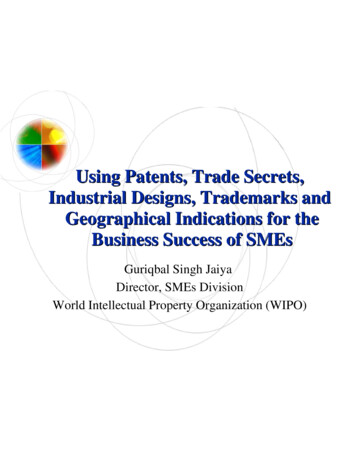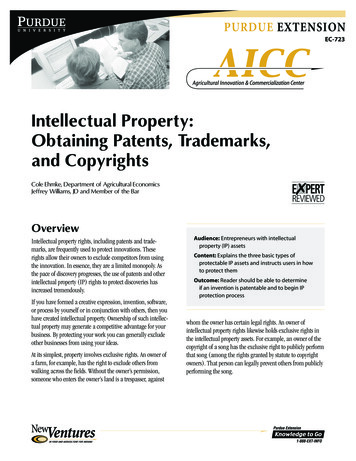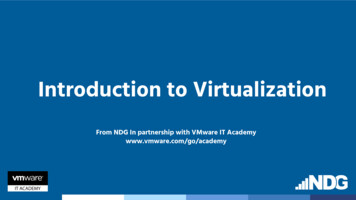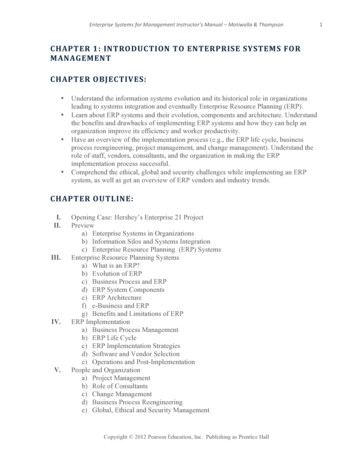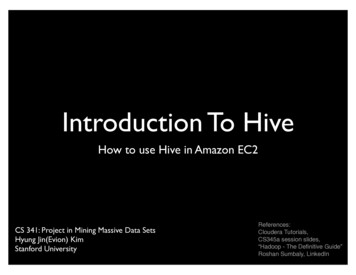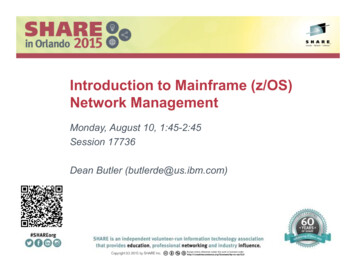
Transcription
WWW.ALSTON.COMIntroduction to PatentsChris Kelly & Josh WeeksOctober 1, 2018Note: The contents of this presentation does not constitute legal advice, should not be relied upon as asubstitute for the direct advice of a licensed attorney, and is intended only as an informational overview ofthe patent system. The various rules and procedures herein are always subject to change. Please consulta registered patent practitioner for legal advice regarding any specific inventions or other legal issues.
WWW.ALSTON.COMPresentation Topics Types of intellectual property Identifying patentable inventions Process for obtaining patents in U.S. & abroad Patent rights & infringement Pitfalls & Strategy Practical considerations
WWW.ALSTON.COMTypes of Intellectual Property
WWW.ALSTON.COMTypes of Intellectual Property: Trademarks A symbol, design, or expression that consumersassociate with a particular brand or product E.g., brand names, logos, or other marks
WWW.ALSTON.COMTypes of Intellectual Property: Copyrights For original works of authorship fixed in any tangiblemedium of expression E.g., books, photos, music
WWW.ALSTON.COMTypes of Intellectual Property: Trade Secrets For formulas, processes, designs, etc. that are notpublicly known and provide an economic advantageto a business E.g., formula for Coca-Cola, Google’s search algorithm,criteria for NYT bestseller list
WWW.ALSTON.COMTypes of Intellectual Property: Patents Utility Patent – for things that are new and useful(machine, method, composition, etc.) Design Patent – for purely aesthetic, non-functionaldesignsUtilityDesign
WWW.ALSTON.COMWhat is a Patent? A right to exclude others from: Making, Using, Selling, Offering for sale, or Importing For a specific location U.S. patents only work in the U.S. protection abroad requires foreign patents For a limited time 20 years from filing for utility patents in the U.S.
WWW.ALSTON.COMWhy does the Government grant these rights? "Congress shall have thepower.to promote the Progressof Science and useful Arts bysecuring for limited Times toAuthors and Inventors theexclusive Right to their respectiveWritings and Discoveries.”U.S. ConstitutionArticle 1, Section 8.
WWW.ALSTON.COMWhat can be patented?How do you get one?
WWW.ALSTON.COMRequirements for Patentability: “Any new and useful process, machine, manufacture,or composition of matter, or any new and usefulimprovement thereof” “Ideas” are not patentable (e.g., an algorithm alone) Software per se is not patentable, but there are stillways to protect software implementations via patents
WWW.ALSTON.COMA patentable invention must be not “obvious” Legal Question: Would the invention have beenobvious to “a person of ordinary skill in the art” atthe time the invention was made? Inventions can come in small advances/improvementsOften involve combinations of known elementsIndicators of non-obviousness: Long-felt but unsolved needs Prior attempts and failure of others Prior art teaches away Commercial successPredictable combinations are often held obvious andnon-patentable
WWW.ALSTON.COMProcess for Obtaining US Patent:1. Prior Art Searching & Pre-Filing Evaluation2. File Provisional Application (optional)3. File Non-Provisional Application (within 12 months ofprovisional)4. Examination by USPTO to Determine if Invention isPatentable5. Patent Issues6. Optional: Can file additional “child” applications beforeissuance (e.g., “continuation” or “divisional” applications)
WWW.ALSTON.COMProvisional Application Placeholder application Disclosure of what you know (so far) No claims required Never examined, never issued, no rights Can be relatively cheap Allows you to claim the benefit of the filing date with anonprovisional application filed within 12 months Great for securing a filing a date and buying yourself oneyear to figure out what to do with the invention
WWW.ALSTON.COMNon-Provisional Application Full description of the invention (with Figures) Must enable person of ordinary skill to practice invention Claims define what you are protecting Examined by patent office and may issue as anenforceable patent Must be filed within 12 months of provisional to claimbenefit of earlier filing date
WWW.ALSTON.COMExamination of Application by USPTO Examiner will search for “prior art” Types of Prior Art Patents & Published Applications (anywhere) Any “printed publication” (articles, books, websites) Public Use / Sale / Offer for Sale Inventor Actions – sale, use, publication, other publicdisclosure more than one year before filing date. Claims can be amended: Examination is a negotiationwith the USPTO over what rights, if any, you are entitled to.
WWW.ALSTON.COMOther Aspects of Application Filing Inventorship Inventors are those who contributed to the conception of theclaimed invention. Inventors have common ownership of patent But assignments, employment agreements, etc. Information Disclosure Statements Must disclose known prior art Filing and prosecution can be done “pro-se” or byregistered practitioner
WWW.ALSTON.COMPatent Rights & Infringement
WWW.ALSTON.COMPorsche invents a new type of convertible
WWW.ALSTON.COMPrior Art: Earlier version of the car
WWW.ALSTON.COMPatent Claims
WWW.ALSTON.COMPatent Claims Like a wall – define the“perimeter” of the property right Claims define what exactly youcan exclude others frommaking/using/selling You are your own“lexicographer.” Words meanwhat you say they mean in thepatent specification.
WWW.ALSTON.COMExample Claim5. A cabriolet vehicle, comprising:a body structure formed with a rear lid, leftand right openings formed through the rearlid,tensioning bracket holding devices mountedto the rear lid and defining inner limits of therespective openings,tensioning brackets fastened to the respectivetensioning bracket holding devices andprojecting into the respective openings; anda roof structure having a top with a topmaterial, the top material having a mainsection and left and right lateral rearelongation sections threaded into openings ofthe body structure and attached to therespective tensioning brackets.
WWW.ALSTON.COMExample Claim5. A cabriolet vehicle, comprising:a body structure formed with a rear lid, leftand right openings formed through the rearlid,tensioning bracket holding devices mountedto the rear lid and defining inner limits of therespective openings,tensioning brackets fastened to the respectivetensioning bracket holding devices andprojecting into the respective openings; anda roof structure having a top with a topmaterial, the top material having a mainsection and left and right lateral rearelongation sections threaded into openings ofthe body structure and attached to therespective tensioning brackets.
WWW.ALSTON.COMExample Claim5. A cabriolet vehicle, comprising:a body structure formed with a rear lid, leftand right openings formed through the rearlid,tensioning bracket holding devices mountedto the rear lid and defining inner limits of therespective openings,tensioning brackets fastened to the respectivetensioning bracket holding devices andprojecting into the respective openings; anda roof structure having a top with a topmaterial, the top material having a mainsection and left and right lateral rearelongation sections threaded into openings ofthe body structure and attached to therespective tensioning brackets.
WWW.ALSTON.COMPatent Infringement Product must include every limitation of at leastone claim. Limitations can be met “literally” or“equivalently” depending on prosecutionhistory of application. E.g., are clips “tensioning brackets”? Velcro?Depends. Product can still infringe open-ended claims,even if it has additional features that are notclaimed.
WWW.ALSTON.COMInfringement Example Accused Product: Lotus Elise Soft Top Meet every limitation? No tensioning brackets Roof does not have lateral rear elongation sections
WWW.ALSTON.COMInfringement Example Accused Product: Porsche Boxster Spyder with Rocket Power. Meet every limitation? Yes. Doesn’t matter that this car adds a super awesomerocket because we used open-ended language in claims
WWW.ALSTON.COMRemedies for Infringement Money Damages “adequate to compensate” for the infringement Can be tripled in cases of willful infringement Largest Patent Verdicts: 2.5 Billion. Merck & Co. v. Gilead Sciences (2016).Hepatitis C drugs. 1.7 Billion. Carnegie Mellon University v. MarvellTechnologies (2013). Integrated circuit technology. 1.05 Billion. Apple v. Samsung (2012). Smartphonetechnology. Injunctions Stops infringer from continuing to infringe More difficult to obtain
WWW.ALSTON.COMPatent Rights Patent grants the right to exclude others from: Making, Using, Selling, Offering for sale, or Importing For a limited time (20 yrs. from filing in the U.S.) For a specific location (e.g., in the U.S.) Not enforceable until patent issues. Only the right to exclude others is granted Does not assure freedom to practice. Product with apatented feature may still infringe other patents.
WWW.ALSTON.COMValue of Patent Rights Enhance Company Value increase valuation, provide source of revenue, use as collateral toobtain loans Attract investors patents make company more attractive to investors; more likely toinvest than compete investors prefer companies with limited or no viable competition Offensive Utility Direct Revenue Source: Licensing, Damages(possibly in other markets) Indirect Revenue Source: Market share, barriers to entry Defensive Utility Provides ammunition for counterclaims in litigation Prevents others from obtaining patent rights that could prevent youfrom making your product
WWW.ALSTON.COMPitfalls, Strategy, & PracticalConsiderations
WWW.ALSTON.COMImportant Pitfalls Any of these things triggers a one-year countdown tofile an application before you forefeit patent rights: Publication (e.g., advertisement, brochure) Public use (e.g., display at trade show) Sale or offer for sale But no grace period abroad (e.g., Europe).Doing any of these things can cause immediateloss of rights abroad. First to File Rule: If two people independently invent the same thing,first to file has rights to the invention. Can institute “derivation” proceeding if someonestealsyour invention and files themselves.
WWW.ALSTON.COMMoney Professional Prior Art Search & Evaluation: 2,000 - 5,000 USPTO Fees (filing, search, exam; always subject to change)ProvisionalNon-Provisional Large EntitySmall EntityMicro Entity 250 125 62 1,260 630 315Attorney’s Fees for Preparing Non-Provisional Patent Application 10,000 to 35,000 depending on subject matter / complexity / rates Attorney’s Fees for Prosecuting Non-Provisional Application Very difficult to predict (often same as, or more than, preparingapplication) Patent Infringement Law Suits are Extremely Expensive 500K to 3M (average) in attorneys fees to get through discovery. 1M to 6M (average) in attorneys fees to get through trial. Highprofile cases even more.
WWW.ALSTON.COMThere Are No Guarantees It is possible your invention is not patentable USPTO finds prior art you were not aware of USPTO decides your invention is obvious If your invention is patentable, it is possible your claimsmight be so narrow the resulting patent has minimal value There is even more uncertainty after the patent issues Patents can be invalidated or cancelled in proceedingsbefore Federal Courts or the USPTO
WWW.ALSTON.COMDealing With Investors, VCs, Venture Partners, Etc. Non-Disclosure Agreements (NDAs) are your friend. Not everyone will agree to sign an NDA. A patent applicationcan give you some leverage to prevent others from stealing youridea. Remember that investors are adverse to you. Be very careful about assigning over your rights to a patent orpatent application. Always know what you are agreeing to. Confidentiality & IP agreements: With customers With suppliers With manufacturers With consultants With partners
WWW.ALSTON.COMTips, Strategies, & Final Thoughts Early consideration of patentability. Beware of statutory bar actionsand deadlines!!!! Consider provisional application filing to buy yourself time. Working prototype is not necessary if invention is fully contemplated. Keep notebooks and other records reflecting timeline of inventionand inventive progress. A patent attorney will do a better job than you at preparing andprosecuting a patent application. If you can afford one, you’rebetter off. Attorneys usually bill by the hour. Make it easy for them by doing yourhomework and providing detailed information. Not getting a patent does not mean your company will fail; getting apatent does not mean your company will succeed. An inventor with a patent is better off than they would be without one.
WWW.ALSTON.COMQuestions?CLT/20010955
Consider provisional application filing to buy yourself time. Working prototype is not necessary if invention is fully contemplated. Keep notebooks and other records reflecting timeline of invention and inventive progress. A patent attorney will do a better job than you at prepari
